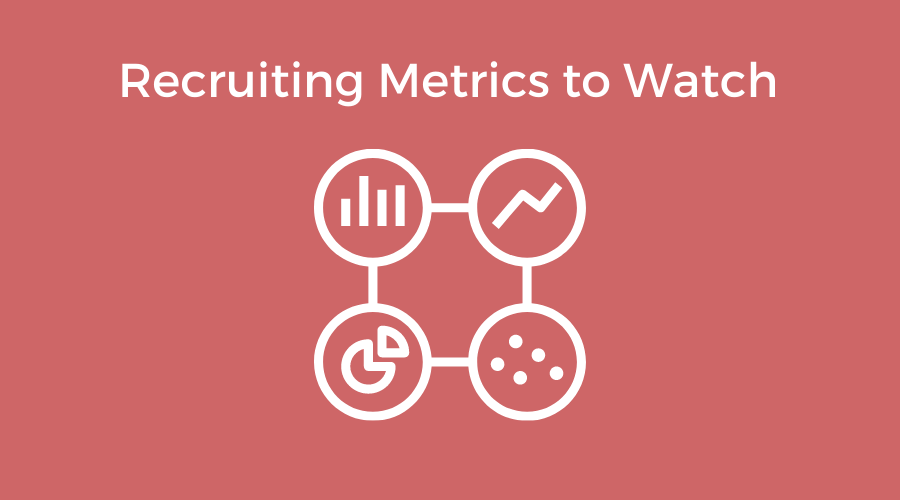Recruiting metrics are a vital measurement of the effectiveness of a talent acquisition program. They speak to the performance of individual recruiters as well as that of the entire recruiting group. They guide the development of recruiting strategies and help talent acquisition professionals learn where they get the best results from their marketing spend.
While large staffing teams track dozens of metrics, no recruiting group, no matter how small, can afford not to measure the most basic of them. Time to fill, cost of hire, source of hire, candidate diversity, and applicants per opening / per hire are among the most essential metrics and the ones most commonly used by recruiting teams.
Ask any group of recruiters and you’ll quickly get a dozen more metrics, all of them valid, useful and critical.
Several years ago, Jibe, a recruiting technology company since acquired by iCIMS, surveyed recruiters about the metrics they most used. In addition to the ones we mentioned, the others that made the top 10 list were: candidate experience, retention, offer acceptance rate, quality of hire and vacancies vs. positions filled.
As much as these metrics might seem like a rock-solid, objective measurement, the reality is that they are each subject to some interpretation. At many companies, the cost of hire metric is what is spent advertising the position and any travel expenses as well as background checks and other direct costs. The more sophisticated measurements include recruiter salary and office overhead, the loss of productivity attributable to the vacant position and other indirect expenses.
A decade ago, the Society for Human Resource Management developed a set of specifications for calculating cost per hire so thorough it runs three dozen pages and is an ANSI standard.
How ever your team calculates the various metrics, as long as you do it consistently, they’re as essential to the recruiting function as financial reports are to investors.
Common Recruiting Metrics
Here’s a brief look at the other nine most commonly tracked metrics and the percentage of recruiters using each, according to the Jibe survey:
-
- Source of hire (57%) – Knowing where your hires are coming helps you make better decisions on where to spend your recruiting budget.
- Time to hire (50%) – Not only does this provide insight to the overall efficiency of the hiring process, it lets you know, which positions take longer so you know where to place an emphasis in building our talent pipeline.
- Applicants per opening / hire (42%) – These two measures work with the source of hire metric to evaluate the effectiveness of individual job postings and sites and recruitment marketing campaigns.
- Candidate experience (41%) – More than ever, the impression applicants have of your recruiting process – from the job posting through the interview process – is essential. A bad experience can damage the company’s brand and negatively impact the quality of candidates who apply. Measuring this is done by surveying candidates.
- Retention (38%) – This may not be an obvious performance indicator for the recruiting group, but it offers insights into the quality of the selection process, the accuracy of the job description and visibility into other aspects of hiring. Most often retention is measure for the first several months and up to a year after hire.
- Offer acceptance per hire (37%) – When the percent of candidates accepting an offer is low or is declining, it’s a signal that there may be a problem with the comp package. When examined in conjunction with the time to fill, it may show that the candidates you want to hire are accepting other offers because the hiring decision is taking too long.
- Quality of hire (36%) – LinkedIn last year found this the most important metric., used by 48%. The reason should be obvious: the best and most talented hires have a disproportionate positive impact on productivity. It’s also the most difficult to measure, taking months or even longer before it’s clear how good a new hire actually is. However, it’s worth making the effort, because great hires make hiring managers happy and demonstrate the value of your recruiting process.
- Vacancies vs. positions filled (36%) – This is a measure of the productivity of the talent acquisition team. The sooner positions are filled, the lower the percentage. Fewer vacancies mean lower costs for the company and better productivity overall.
- Diversity (25%) – The LinkedIn survey found 34% of recruiting professionals today track the diversity of candidates and hires and 56% declare the metric will very useful in the coming years. In addition to the strong social value of a diverse workforce, studies show the positive impact diverse teams have on innovation and revenue.
This list is just a sample of the wide variety of metrics recruiting teams used to measure their performance. If the Jibe survey were to be conducted today, there’s no doubt many of these measures would still make the top 10. As the LinkedIn survey demonstrated, the percentages of talent acquisition teams that monitor them would change.
LinkedIn’s Future of Recruiting report says the two most significant metrics in today’s world are quality of hire and sourcing channel effectiveness, a measure like source of hire. Knowing where the top talent was sourced, doesn’t just improve the recruiting process, as LinkedIn notes, “It speaks to the long-term business impact of new employees — and your recruiters.”
### John Zappe, Reporting ###


